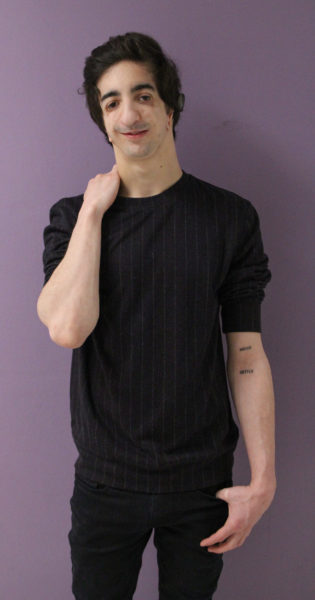
In January, Teen Vogue featured you in an article about disability representation in fashion. How did that come about?
My roommates got me tickets to a panel discussion at Parsons called “Fashion Culture and Justice.” One of the panelists was the editor in chief of Teen Vogue. I felt my narrative wasn’t represented, so I went to the mike and said, “What are you doing to promote people with disabilities in the industry? We’re the largest minority group in America, but there’s still no diversity. Growing up, I never saw TV characters like me.” The editor grabbed the mike and said, “I want to work with you.”
What was the collaboration like?
I was interviewed at Condé Nast headquarters. I wrote a sidebar—a Q&A about questions I get as an individual with a disability, like, “How do I ask about someone’s condition?” I even got paid for it. It was really great.
Tell me about your condition.
It’s a facial anomaly called Treacher Collins Syndrome. My mom has it also. One possible side effect is hearing impairment, so I wear hearing aids. I grew up disabled and gay in the suburbs of Virginia, where everyone’s the same. Here in New York, I think kids are more exposed to difference.
You teach gymnastics part time at Chelsea Piers. Why that gig?
From age 7 to 17, I was a competitive gymnast. I did all the events—floor exercise, horizontal bar, parallel bars, still rings, vault, and pommel horse. The sport was a constant adrenaline rush, but what excited me more was the audience’s reaction to seeing me do a flip. Able-bodied individuals tend to have limited expectations of what an individual with a disability can achieve. Why is something like gymnastics or fashion something I couldn’t do?
How did you get interested in fashion?
Early on, I realized I stood out for how I looked, but I wanted to get beyond that. I’d study what the popular kids wore. I used fashion to blend in. Now I want my work to represent me. My ideas stand out.
What do you see as your role in the industry?
I want to translate my story into fashion. For example, I’m exploring the possibility of weaving 3D-printed copies of my hearing aid batteries into a textile, for ornamentation. This summer, I have a paid internship at Tommy HiIfiger. They have me working in multiple departments, including their new Tommy Adaptive line for individuals with disabilities.
You won a critic award in your fourth semester. What was your garment?
It was a white double-face wool top embroidered with the words “Never Settle,” with more than 400 strands of yarn unraveling from the text. I later got this phrase tattooed on my arm because it’s something my mother always told me. When I’m older and I can look back and say I’ve attempted everything I dreamed of, I want to add a “d” at the end.